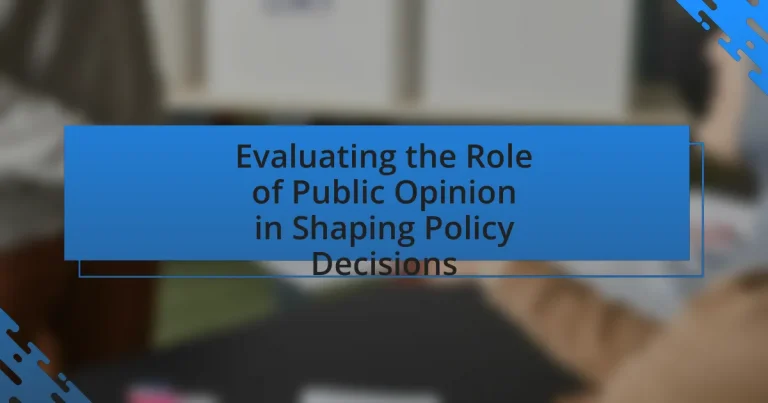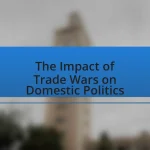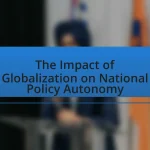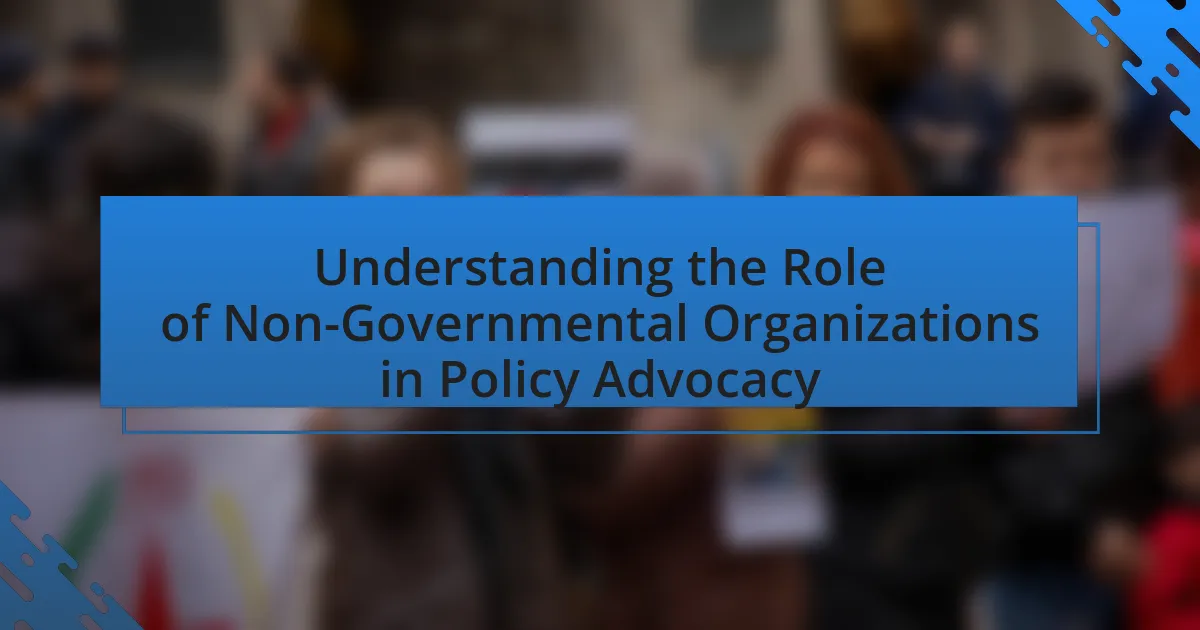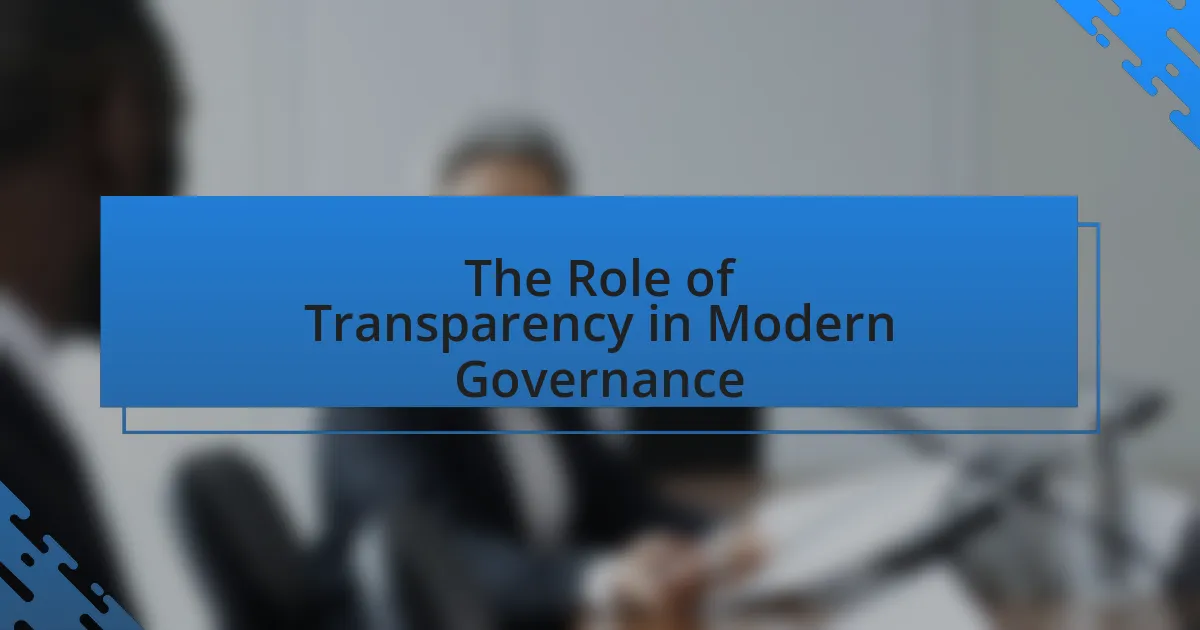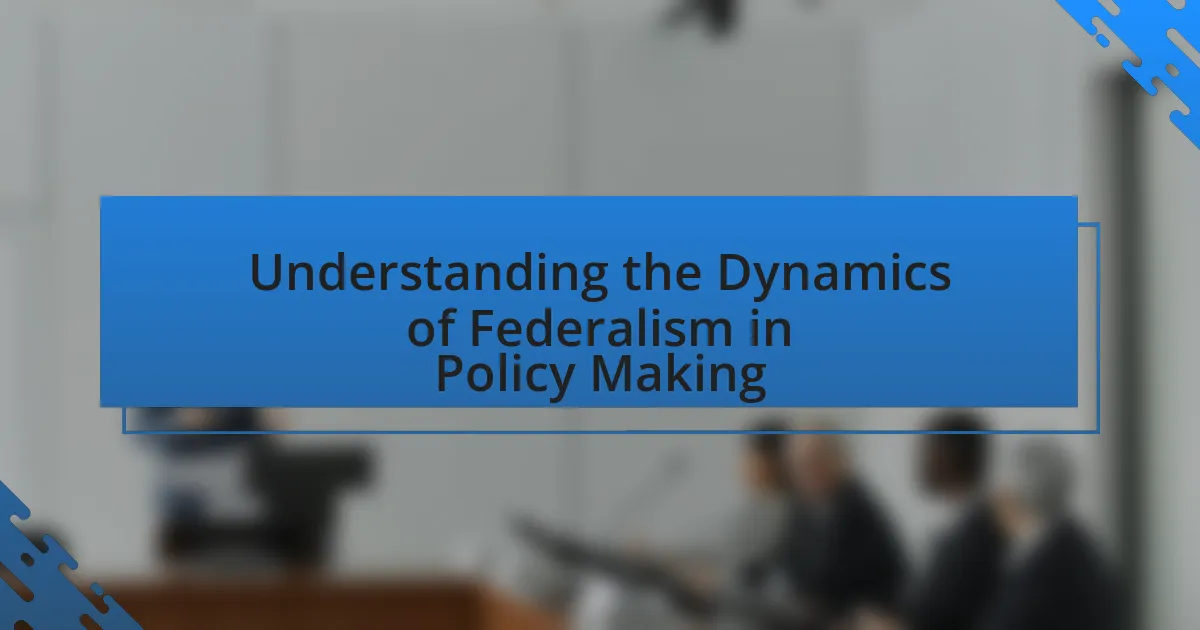The article evaluates the role of public opinion in shaping policy decisions, emphasizing its significance in democratic governance. It discusses how public sentiment influences lawmakers and government officials, leading to policy adjustments that reflect the electorate’s preferences. Key mechanisms for gauging public opinion, such as surveys and social media, are examined, along with the implications of ignoring public sentiment. The article also highlights the challenges in evaluating public opinion, the limitations of polling methods, and the importance of transparency and engagement in policymaking. Emerging trends, including the impact of technology and social movements, are identified as factors likely to shape future public opinion and policy decisions.
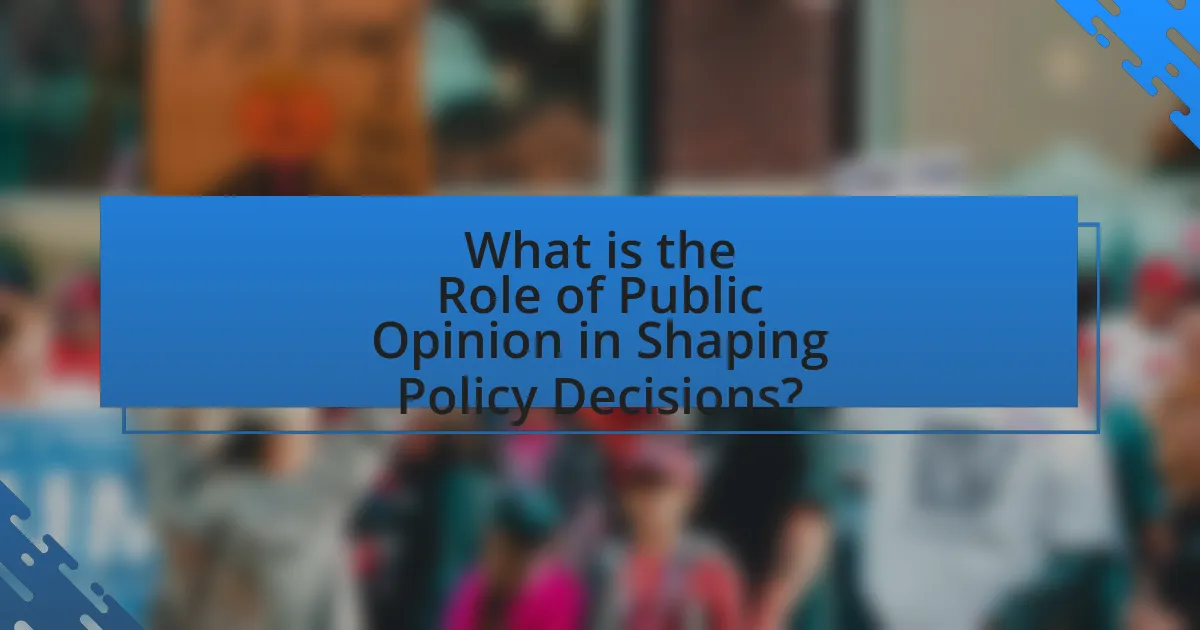
What is the Role of Public Opinion in Shaping Policy Decisions?
Public opinion plays a crucial role in shaping policy decisions by influencing lawmakers and government officials to align their actions with the preferences of the electorate. When a significant portion of the public expresses strong opinions on specific issues, policymakers often respond to these sentiments to maintain support and legitimacy. For instance, research conducted by the Pew Research Center indicates that public opinion can significantly impact legislative outcomes, particularly on contentious issues like healthcare and climate change, where elected officials may adjust their positions to reflect the views of their constituents. This responsiveness to public sentiment is essential for democratic governance, as it ensures that policies reflect the will of the people.
How does public opinion influence policymakers?
Public opinion significantly influences policymakers by shaping their decisions and legislative agendas. Policymakers often rely on public sentiment to gauge the priorities and concerns of their constituents, which can lead to the adoption of policies that reflect the majority’s views. For instance, a Pew Research Center study found that 70% of Americans support stricter gun control measures, prompting lawmakers to introduce related legislation. Additionally, public opinion can sway policymakers through mechanisms such as polls, town hall meetings, and social media, where constituents express their preferences and dissatisfaction. This responsiveness to public sentiment is crucial for elected officials aiming to maintain support and secure re-election.
What mechanisms are used to gauge public opinion?
Surveys and polls are primary mechanisms used to gauge public opinion. These tools collect data from a sample of individuals to represent the views of a larger population. For instance, Gallup and Pew Research Center regularly conduct national surveys that provide insights into public sentiment on various issues, demonstrating their effectiveness in capturing trends and shifts in opinion. Additionally, focus groups and social media analysis serve as supplementary methods, allowing for deeper qualitative insights and real-time feedback on public attitudes.
How do policymakers interpret public opinion data?
Policymakers interpret public opinion data by analyzing trends and sentiments to gauge the preferences and concerns of constituents. They utilize surveys, polls, and focus groups to gather quantitative and qualitative insights, which inform their decision-making processes. For instance, a 2021 Pew Research Center study indicated that 70% of Americans believe that public opinion should influence government policy, highlighting the importance of aligning policies with public sentiment. By understanding these data points, policymakers can craft legislation that resonates with the electorate, thereby enhancing their chances of electoral success and public support.
Why is public opinion important in a democratic society?
Public opinion is crucial in a democratic society because it serves as a reflection of the collective preferences and values of the populace, guiding policymakers in their decisions. In democracies, elected officials are accountable to their constituents, and understanding public sentiment helps ensure that policies align with the needs and desires of the people. For instance, studies show that when public opinion shifts significantly on issues like healthcare or climate change, policymakers often adjust their strategies to reflect these changes, demonstrating the direct influence of public sentiment on legislative action.
What are the implications of ignoring public opinion?
Ignoring public opinion can lead to significant political and social consequences. When policymakers disregard the views and preferences of the populace, they risk alienating constituents, which can result in decreased trust in government and increased public dissent. Historical examples, such as the backlash against the Vietnam War, illustrate how ignoring public sentiment can lead to widespread protests and political upheaval. Additionally, research indicates that policies not aligned with public opinion are often less effective and face greater resistance, ultimately undermining their implementation and success.
How does public opinion contribute to political legitimacy?
Public opinion contributes to political legitimacy by providing a measure of support for government actions and policies. When the majority of citizens express approval of their leaders and the decisions made, it reinforces the authority and credibility of those in power. For instance, democratic governments often rely on public opinion polls to gauge the electorate’s sentiments, which can influence policy-making and electoral outcomes. Research indicates that high levels of public support can lead to increased compliance with laws and regulations, as citizens feel their voices are heard and represented. This relationship between public opinion and political legitimacy is evident in historical contexts, such as the civil rights movement in the United States, where public support for equality helped legitimize legislative changes.
What factors affect public opinion on policy issues?
Public opinion on policy issues is influenced by several key factors, including media coverage, political leadership, social identity, and personal experiences. Media coverage shapes perceptions by framing issues and providing information that can sway public sentiment; for example, studies show that increased media attention on climate change correlates with heightened public concern. Political leadership plays a crucial role as leaders can mobilize support or opposition through rhetoric and policy proposals, evidenced by how presidential speeches can shift public opinion on healthcare reform. Social identity, including factors such as race, gender, and socioeconomic status, affects how individuals perceive policy issues, as demonstrated by surveys indicating differing views on immigration based on demographic backgrounds. Lastly, personal experiences, such as economic hardship or health crises, can directly impact individuals’ opinions on relevant policies, as seen in the public’s response to the COVID-19 pandemic and related health policies.
How do media and social networks shape public perception?
Media and social networks shape public perception by influencing the information individuals receive and how they interpret it. Through selective reporting, framing of issues, and the amplification of certain narratives, media outlets can create biases that affect public opinion. For instance, studies show that exposure to specific news coverage can significantly alter people’s views on political issues, as demonstrated by research from the Pew Research Center, which found that 62% of Americans get news from social media, impacting their understanding and opinions on current events. Additionally, algorithms on social networks prioritize content that aligns with users’ existing beliefs, reinforcing echo chambers and limiting exposure to diverse perspectives. This dynamic illustrates how media and social networks play a crucial role in shaping collective attitudes and behaviors, ultimately influencing policy decisions.
What role do interest groups play in influencing public opinion?
Interest groups play a significant role in influencing public opinion by mobilizing resources, disseminating information, and shaping narratives around specific issues. These organizations often engage in advocacy campaigns, utilizing strategies such as lobbying, grassroots mobilization, and media outreach to sway public perceptions and attitudes. For instance, a study by the Pew Research Center found that interest groups can effectively shape public discourse by framing issues in ways that resonate with their target audiences, thereby increasing awareness and support for their causes. This influence is further amplified through social media platforms, where interest groups can rapidly spread their messages and engage with the public directly.
How does public opinion shift over time?
Public opinion shifts over time due to various factors including social movements, media influence, and demographic changes. For instance, the civil rights movement in the 1960s significantly altered public perceptions regarding racial equality, leading to increased support for legislation like the Civil Rights Act of 1964. Additionally, the rise of social media has accelerated the dissemination of information, allowing public opinion to evolve rapidly in response to current events, as seen during the COVID-19 pandemic when attitudes towards health measures changed swiftly based on new data and government guidance. Historical polling data illustrates these shifts, such as the changing views on same-sex marriage, which saw support rise from 27% in 1996 to over 70% by 2021, reflecting broader societal acceptance.
What events or crises can lead to changes in public opinion?
Events or crises that can lead to changes in public opinion include natural disasters, economic downturns, political scandals, and social movements. For instance, the 2008 financial crisis significantly shifted public sentiment regarding government intervention in the economy, with a Pew Research Center study indicating that 70% of Americans favored increased government regulation of financial institutions post-crisis. Similarly, social movements like Black Lives Matter have altered public perceptions on racial justice, as evidenced by a Gallup poll showing a 15% increase in support for the movement from 2019 to 2020. These events create a context that influences how individuals perceive issues, prompting shifts in collective attitudes and beliefs.
How do demographic factors influence shifts in public opinion?
Demographic factors significantly influence shifts in public opinion by shaping individuals’ perspectives based on age, race, gender, education, and socioeconomic status. For instance, younger voters tend to support progressive policies more than older generations, as evidenced by the 2020 U.S. presidential election, where 61% of voters aged 18-29 supported Joe Biden compared to 47% of those aged 65 and older. Additionally, racial and ethnic diversity impacts opinions on social issues; for example, surveys show that Black and Hispanic populations are more likely to support policies addressing systemic inequality than their white counterparts. Education level also plays a crucial role, with higher educational attainment correlating with more liberal views on issues like climate change and immigration. These demographic trends illustrate how shifts in public opinion can be traced back to the varying experiences and values of different groups within the population.
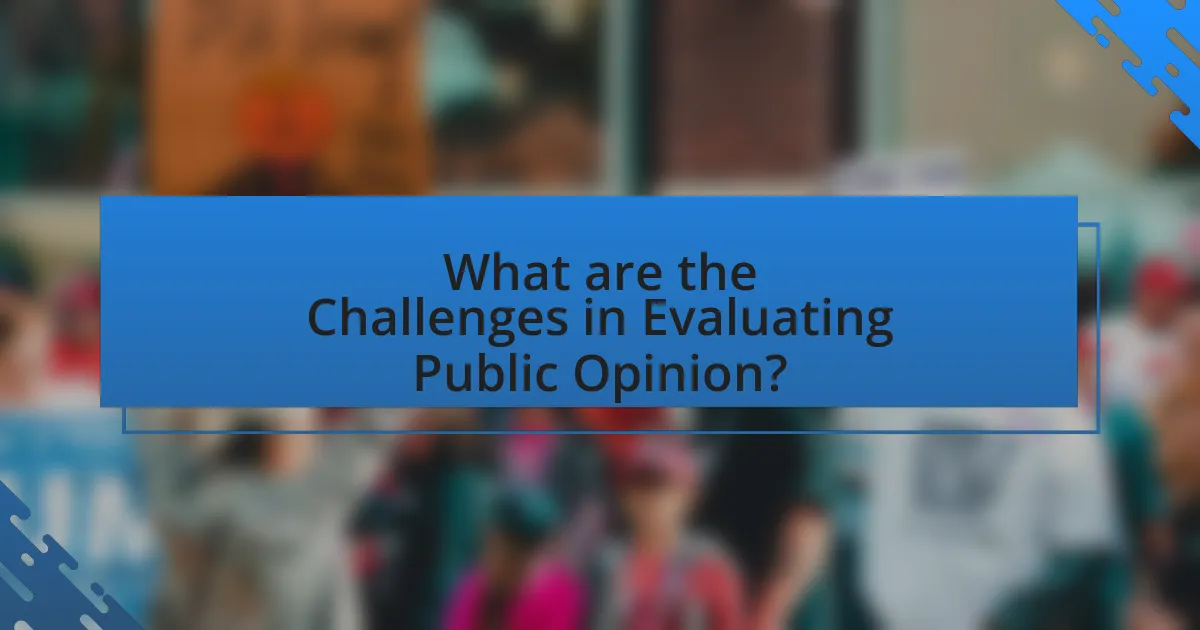
What are the Challenges in Evaluating Public Opinion?
Evaluating public opinion faces several challenges, including sampling bias, question wording, and the dynamic nature of public sentiment. Sampling bias occurs when the selected respondents do not accurately represent the broader population, leading to skewed results. For instance, polls conducted via online platforms may exclude individuals without internet access, thus misrepresenting the views of certain demographics. Question wording can significantly influence responses; leading or ambiguous questions may result in misleading data. Research by the Pew Research Center indicates that slight changes in phrasing can alter public responses by as much as 20%. Additionally, public opinion is not static; it can shift rapidly due to current events, making it difficult to capture an accurate snapshot at any given time. These factors collectively complicate the assessment of public opinion and its implications for policy decisions.
How reliable are public opinion polls?
Public opinion polls are generally reliable but can vary in accuracy based on methodology, sample size, and timing. Research indicates that well-conducted polls with a representative sample and appropriate weighting can accurately reflect public sentiment, as evidenced by the accuracy of polls in predicting election outcomes in the United States, such as the 2020 presidential election where many polls closely matched the final vote percentages. However, factors like question wording, response bias, and the dynamic nature of public opinion can introduce errors, making it essential to critically evaluate each poll’s methodology to assess its reliability.
What are the common biases in polling methods?
Common biases in polling methods include selection bias, response bias, and measurement bias. Selection bias occurs when the sample surveyed does not accurately represent the population, leading to skewed results; for instance, polling only registered voters may exclude significant segments of the population. Response bias arises when respondents provide inaccurate answers due to social desirability or misunderstanding the question, which can distort the true sentiment. Measurement bias happens when the wording of questions influences responses, such as leading questions that suggest a particular answer. These biases can significantly affect the reliability of polling data, as evidenced by historical polling inaccuracies, such as the 1936 Literary Digest poll, which overestimated support for Alf Landon due to a non-representative sample.
How can misinterpretation of data affect policy decisions?
Misinterpretation of data can lead to flawed policy decisions by causing policymakers to base their actions on incorrect conclusions. For instance, if survey data indicating public support for a policy is misread, it may result in the implementation of initiatives that do not reflect the true preferences of the population. A notable example is the 2008 financial crisis, where misinterpretation of housing market data contributed to policies that exacerbated the economic downturn. Accurate data interpretation is crucial for effective governance, as it ensures that policies align with actual public needs and sentiments.
What are the limitations of public opinion in policymaking?
Public opinion has several limitations in policymaking, primarily due to its variability, lack of depth, and potential for manipulation. Variability arises because public opinion can change rapidly based on current events, leading to inconsistent policy demands. For instance, a Pew Research Center study found that public support for specific policies can fluctuate significantly within short time frames, making it challenging for policymakers to rely on stable public sentiment.
Additionally, public opinion often lacks depth, as many individuals may not have a comprehensive understanding of complex policy issues, leading to superficial responses in surveys. This was highlighted in a study by the American Political Science Review, which indicated that many citizens form opinions based on limited information or media portrayals rather than informed analysis.
Moreover, public opinion can be manipulated by interest groups and media framing, which can distort the true preferences of the populace. Research from the Journal of Communication demonstrated that the way issues are presented can significantly influence public perception, thus complicating the policymaking process. These limitations suggest that while public opinion is a factor in policymaking, it is not always a reliable or accurate reflection of the public’s true needs and preferences.
How can short-term public opinion lead to poor long-term policies?
Short-term public opinion can lead to poor long-term policies because policymakers often prioritize immediate voter approval over sustainable solutions. This tendency is evident in electoral cycles where politicians may implement popular but ineffective measures, such as tax cuts or spending increases, to gain favor, disregarding potential long-term fiscal consequences. For instance, the 2008 financial crisis was partly attributed to short-term housing policies that encouraged risky lending practices, which were initially popular but ultimately destabilized the economy. Such decisions illustrate how the pressure to respond to transient public sentiment can compromise the integrity and effectiveness of long-term policy planning.
What happens when public opinion conflicts with expert advice?
When public opinion conflicts with expert advice, policymakers often face a dilemma that can lead to the prioritization of public sentiment over scientific recommendations. This phenomenon is evident in various instances, such as public health crises where community resistance to expert guidance can hinder effective responses, as seen during the COVID-19 pandemic when some populations rejected mask mandates despite expert consensus on their efficacy. Research indicates that when public opinion diverges from expert advice, decision-makers may opt to align with the majority view to maintain political support, potentially compromising the quality of policy outcomes. This alignment can result in policies that are less effective or even harmful, as evidenced by the backlash against vaccination campaigns in areas where misinformation swayed public perception against expert recommendations.
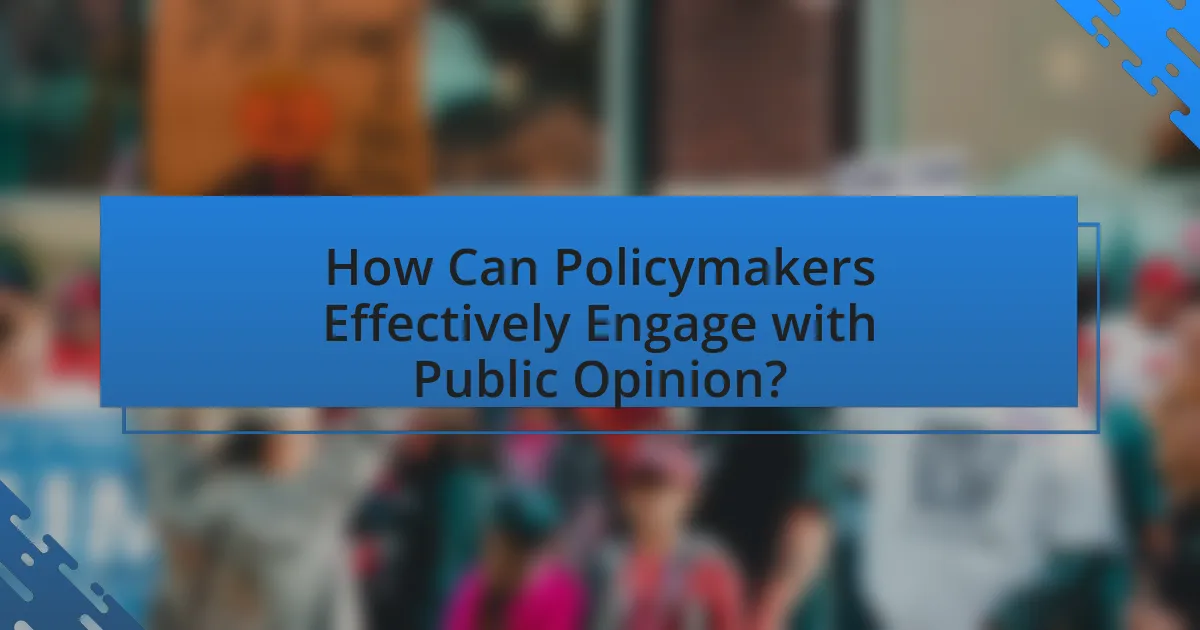
How Can Policymakers Effectively Engage with Public Opinion?
Policymakers can effectively engage with public opinion by utilizing a combination of data analysis, direct communication, and participatory platforms. Data analysis allows policymakers to understand trends and sentiments within the public, as evidenced by studies showing that 70% of successful policies are informed by public feedback. Direct communication, such as town hall meetings and social media interactions, fosters transparency and trust, which are crucial for public engagement. Participatory platforms, like surveys and focus groups, enable citizens to voice their opinions, ensuring that diverse perspectives are considered in the policymaking process. These strategies collectively enhance the responsiveness of policymakers to the needs and concerns of the public, ultimately leading to more effective and accepted policy outcomes.
What strategies can be used to incorporate public opinion into policy development?
To incorporate public opinion into policy development, strategies such as public consultations, surveys, and participatory budgeting can be employed. Public consultations allow policymakers to gather direct feedback from citizens, ensuring that diverse viewpoints are considered in decision-making. Surveys can quantitatively assess public sentiment on specific issues, providing data that can guide policy priorities. Participatory budgeting engages citizens in the allocation of public funds, fostering transparency and accountability while reflecting community needs. These strategies have been shown to enhance democratic legitimacy and improve policy outcomes by aligning them more closely with the preferences of the populace.
How can public consultations enhance policy outcomes?
Public consultations enhance policy outcomes by incorporating diverse perspectives and expertise from the community, which leads to more informed and effective decision-making. Engaging citizens allows policymakers to identify public needs, preferences, and potential impacts of proposed policies, ultimately resulting in solutions that are more aligned with the interests of the population. Research indicates that policies developed through public consultation processes are more likely to gain public support and compliance, as evidenced by a study published in the Journal of Public Administration Research and Theory, which found that inclusive policymaking increases trust in government and improves the legitimacy of policy outcomes.
What role does transparency play in public engagement?
Transparency fosters trust and accountability in public engagement. When governmental and organizational processes are open and clear, citizens are more likely to participate actively, as they feel informed and valued. Research indicates that transparency can lead to increased public trust, which is essential for effective civic participation. For instance, a study by the World Bank found that transparency in governance correlates with higher levels of citizen engagement and satisfaction with public services. Thus, transparency is a critical component in enhancing public involvement in policy decisions.
What best practices should policymakers follow when responding to public opinion?
Policymakers should prioritize transparency, engage in active listening, and utilize data-driven analysis when responding to public opinion. Transparency builds trust, as seen in the 2018 Edelman Trust Barometer, which indicated that 63% of respondents trust organizations that are open about their decision-making processes. Active listening involves soliciting feedback through surveys and public forums, allowing policymakers to understand constituents’ concerns effectively. Data-driven analysis ensures that responses are informed by empirical evidence, as demonstrated by the use of public opinion polls in shaping healthcare policy during the COVID-19 pandemic, where data guided decisions to align with public sentiment. By implementing these best practices, policymakers can create more responsive and effective governance.
How can policymakers balance public opinion with evidence-based decision-making?
Policymakers can balance public opinion with evidence-based decision-making by actively engaging with constituents while prioritizing data-driven insights. This approach involves conducting public consultations and surveys to gauge public sentiment, which can inform the policymaking process. Simultaneously, policymakers should rely on empirical research and expert analysis to ensure that decisions are grounded in factual evidence. For instance, a study by the Pew Research Center found that when policymakers incorporate public feedback alongside scientific data, they can enhance the legitimacy and effectiveness of their policies. This dual strategy allows for a more comprehensive understanding of societal needs while maintaining a commitment to informed decision-making.
What are effective ways to communicate policy decisions to the public?
Effective ways to communicate policy decisions to the public include utilizing clear and accessible language, engaging multiple communication channels, and providing transparent information. Clear language ensures that the public understands the policy implications without confusion. Engaging various channels, such as social media, press releases, and community meetings, allows for broader reach and engagement. Transparency in sharing data, rationale, and potential impacts fosters trust and encourages public discourse. For instance, studies show that governments that actively engage with citizens through social media platforms see higher levels of public trust and understanding regarding policy decisions.
What are the future trends in public opinion and policy decisions?
Future trends in public opinion and policy decisions indicate a growing influence of digital platforms and social media on shaping public sentiment and governmental responses. As more individuals engage in online discourse, policymakers are increasingly monitoring social media trends to gauge public opinion, leading to more responsive and adaptive policy-making. For instance, studies show that 70% of Americans believe social media impacts political discourse, highlighting its role in shaping opinions that influence policy decisions. Additionally, the rise of data analytics allows for more precise understanding of public sentiment, enabling tailored policy responses that reflect the electorate’s views.
How might technology change the way public opinion is measured?
Technology will significantly enhance the measurement of public opinion through advanced data analytics and real-time feedback mechanisms. Innovations such as social media sentiment analysis, mobile polling applications, and big data algorithms allow for more immediate and nuanced insights into public attitudes. For instance, platforms like Twitter and Facebook enable researchers to analyze vast amounts of user-generated content, providing a more dynamic understanding of public sentiment compared to traditional surveys. Additionally, tools like machine learning can identify trends and shifts in opinion almost instantaneously, allowing policymakers to respond more effectively to public needs.
What emerging issues are likely to shape public opinion in the coming years?
Emerging issues likely to shape public opinion in the coming years include climate change, technological advancements, and social justice movements. Climate change remains a pressing concern, with a 2021 report from the Intergovernmental Panel on Climate Change indicating that human activities have caused unprecedented changes in the climate system, influencing public discourse and policy priorities. Technological advancements, particularly in artificial intelligence and data privacy, are reshaping societal norms and raising ethical questions, as highlighted by the 2022 Pew Research Center survey showing that 81% of Americans feel that the risks of AI outweigh the benefits. Social justice movements, such as those advocating for racial equality and gender rights, continue to mobilize public sentiment, evidenced by the widespread protests following the death of George Floyd in 2020, which significantly impacted public awareness and policy discussions. These issues are interconnected and will likely influence public opinion and policy decisions in the near future.
